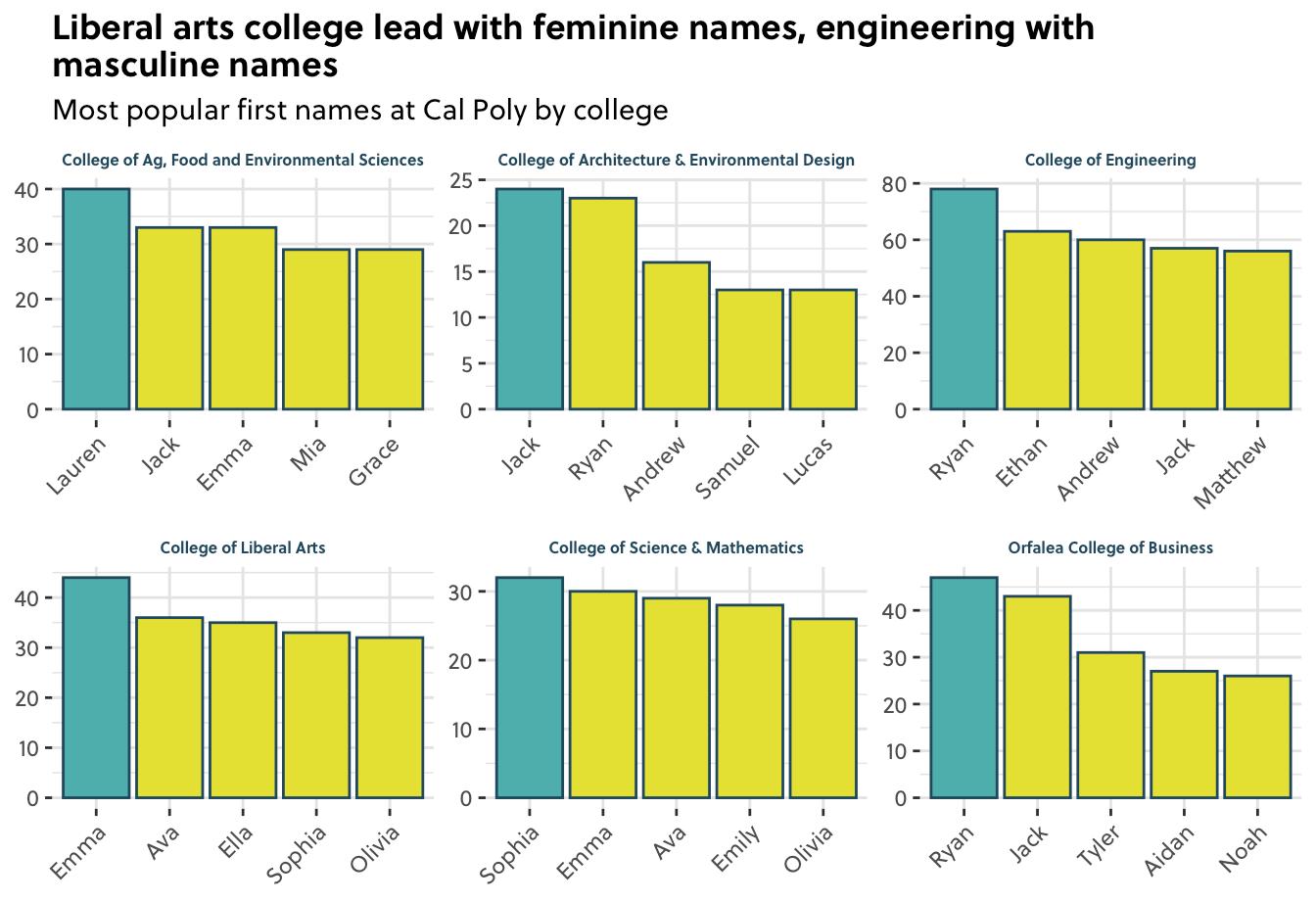MUSTANG NEWS



Cal Poly’s Quinn Mahoney found his ‘why’ – and the Big West title
Pg. 3 FRENCH GRAPE VARIETAL TAKES ROOT AT CAL POLY WINERY Pg. 6
IN EVERY HELMET, A HEARTFELT TRIBUTE; CAL POLY FOOTBALL REMEMBERS KEITH MARCO
Pg. 11 A DILL-IGHTFUL DAY: SAN LUIS OBISPO HOSTS INAUGURAL PICKLE FESTIVAL
Amelia Wu Editor in Chief
NEWS
Caroline Ohlandt Editor
Katy Clark Assistant Editor
Nick Forselles
Abby Gorman
Leila Touati
Kaylin O’Connell
Bella Cox
Livia Angelini
Ava Tourgeman
Alex Kohm
Aditi Sriram
Riya Parekh
OPINION
Landon Block Editor
Erin Yarwood
Kaylie Wang
Ash Pickett
Brie Thompson
John Washington
Larena Tannert
Ani Nazarian
SPORTS
Sergio Romero Editor
Anthony Molleson Video
Nadeen Maniord Manager
Nick Bandanza
Mark Robinson
Matthew Muren
Jonathan Sze
Joslen Jimenez
Ava Keshtkar
Andrew Aguiniga
Oliver Marburg
Coulter Langmaid
Lano Somotun
Andrea Aruino
Amanda Avila
Joe Forrestdavis
Ryan Giacomini
Ty Soria
Charlie Wiltsee
Dylan Allen
Jai Gulati
Jack Bynum
Warren Notrica
Rocco Brichler
DESIGN
Brandon Schwartz Creative Director
Aviv Kesar
Elizabeth Ridley
Kennedy Ray
Julia Hazemoto
Jolina Chen
Audrey Walch
Isa Cordovez
ARTS & STUDENT LIFE
Syd Spencer Editor
Kaylie Wang
Matthew Ho
Managing Editor
Brandon Schwartz
Creative Director
Maya Ziv
Rebecca Von Tersch
Sofia Livia
Katherine Lu
Vinithra Seshan
Kimber Draughon
Megan Tang
Makena Locsin
VIDEO
Cassandra Garcia Video Manager
RJ Pollock
Izzy Romero
Jessica Carp
Lauren Quijano
Emma Montalbano
PHOTO
Maura Shernisky Editor
Owen Roberts
Brandon Bomberger
Dijia Wang
Christina Thai
Eleanor Vickery
Soha Roy
Chloe Briote-Johnson
Andrea Aruino
Paige Teraji
Eyasu Betwos
SOCIAL MEDIA
Archana Pisupati Social Media
Manager
Avery Smigel
Ava Zamoff
Zoë Laureta
Gabrielle Ottaviano
Millie Marshall
Marlene Arroyo
Olivia Roman
Skylar Novak
Elizabeth Morton
DATA & INVESTIGATIONS
Elizabeth Wilson
Angel Corzo
Jeremy Garza
Alie Hall
Alex Tran
BILINGUAL
Kathyrn Hutchinson Editor
KCPR
LEADERSHIP
Kat Orozco Content Director
Emmy Burrus KCPR News Director
Mairi O’Toole Art Director
Amelia Nored Programming/
Music Director
Sophia Ermisch Marketing Director
Ben Shane Podcast Manager
KCPR NEWS
Emmy Burrus Director
Emma Montalbano Assistant Director
Cassandra Garcia
MNTV News Director
Leila Touati
Digital Director
Riley Sullivan
Sergio Romero
Izzy Romero
Fiona Hastings
Cayden Tan
Nadeen Maniord
Talie Krantz
Gabriella Lipsky
Ty Soria
Giselle Espinoza
Evelyn Santa Rosa
Delaney Ridder
Lauren Quijano
KCPR CONTENT
Kat Orozco Content Director
Angie Stevens Editorial Assistant
Ruby Citrin
Ella Giuliani
Asmahan Karam
Marley Logan
Olivia Nieporte
Gabrielle Ottaviano
Constantine Golematis
Bailee Isackson
ADVERTISING & PR
Sean Harmon Advertising Manager
Emma James
Alexander Poroy
Sydnie Bierma Special Sections Editor
Morgan Fitzgerald Marketing and
Public Relations Director
Amanda Wahl Advertising Design
Manager
Leah Coffey Marketing Assistant
ADVERTISING DESIGNERS
Ashley Ho
Christine Kim
Teia Kornienko
ADVERTISING ACCOUNT EXECUTIVES
Ruby Beye
Tara Davari
Kayla Harmon
Angie Ho
Kendall Jones
Julia Moore
Janalee Taguiam
Logan Teixeira
SPECIAL SECTIONS WRITERS
Sydnie Bierma Editor
Samantha Orradre
Kaitlyn Knopf
Kate Roarke
Madison White
Ashley Bates
Lillian Dolph
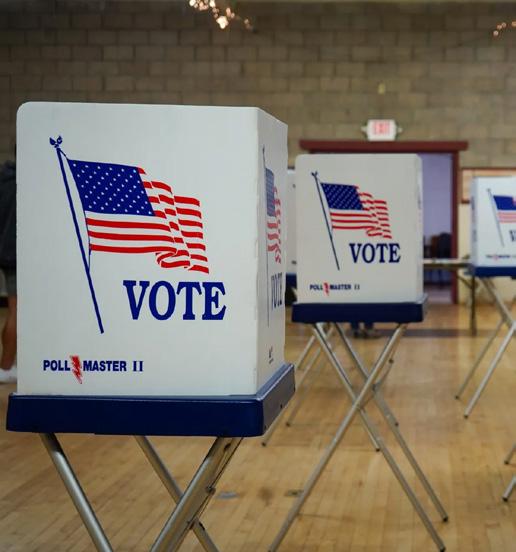

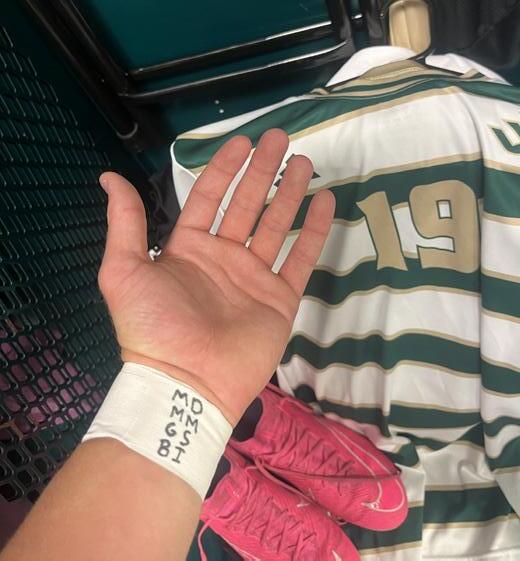
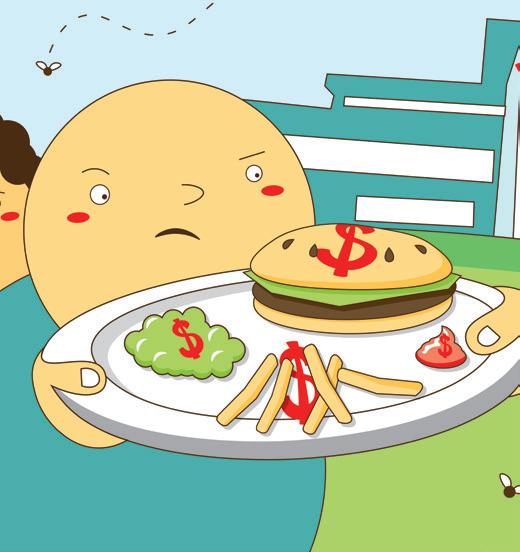

Pat
Kim
Patti
BY IZZY ROMERO
Students at the Cal Poly Winery were hard at work during their fall harvest season. This year, Syrah, a new red wine grape varietal to Cal Poly, was the star of the show. The harvest followed wine grapes surpassing strawberries for the county’s high-earning agricultural product in 2023, according to a San Luis Obispo County report.
Despite this statistic, the Cal Poly Winery faced a distinctive 2024 harvest with lower yields than normal, with the exception of their Syrah.
The wine originates in France, “falling under the main category of wine grapes which is vitis vinifera, but Syrah is the specific variety which originates from France,” wine and viticulture senior and winery intern Augusta Schulte said. According to Schulte, they grafted over Syrah vines to the on-campus Trestle Vineyard a couple of years ago. Since the Syrah vines are so young, they proved vigorous in their first harvest, and Schulte thinks they got about five tons of grapes. Students like Schulte worked to sort and process the Syrah with the “lasagna method” for fermentation, a term wine and viticulture professor Federico Casassa coined. “[For] this variety in particular, we are making it in a way in which we are keeping the clusters whole at the bottom of the fermenter,” Casassa said. “We top them with crushed berries, and then we put, again, whole clusters, and top them with crushed berries so it almost resembles a lasagna.”
The overall lower yield this harvest is in the winery’s favor.
Yields this year have been slightly lower than expected, and that’s a good thing because we’re going to have lower production, and lower production is going to decompress the market.
FEDERICO CASASSA Professor of Wine and Viticulture at Cal Poly
According to Casassa, the wine industry at large is facing an excess in supply and a drop in wine consumption.
“Yields this year have been slightly lower than expected, and that’s a good thing because we’re going to have lower production, and lower production is going to decompress the market,” Casassa said. “If we have an overproduction, there is an oversupply and the price goes down.”
The Cal Poly Winery is split into three sections: commercial production, research and instruction. Students are involved in all departments and aspects.
In commercial production, grapes are grown at the Trestle Vineyard by the crops unit on campus. Then the fruits go through a sort and destem process and the fermenter to become wine for sale. Revenue from the winery funds projects within the program. Research is spearheaded by Casassa and four graduate students who try out different methods of winemaking, allowing wine and viticulture classes to offer in-class opportunities to make wine.
Cal Poly Wine can be found in San Luis Obispo at the Cal Fresh Market and the Cal Poly Mustang Shop Downtown.

This story earned first place in the Broadcast News Story, Best of Show category at the 2024 Associated Collegiate Press award show. To watch the full video, visit the QR link below.



SCAN

What did Mustang News photographers see on Election Day?
BY OWEN ROBERTS, CHRISTINA THAI AND ELEANOR VICKERY
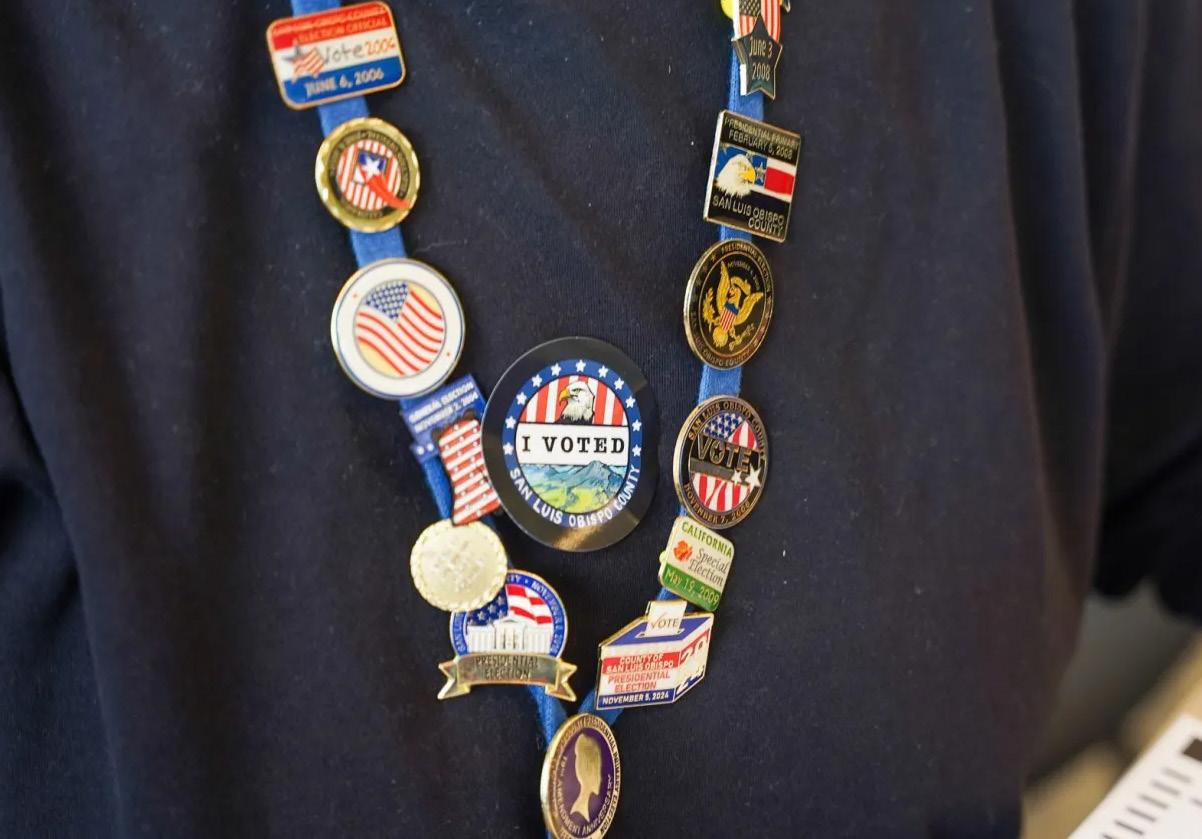





ASI Vice Chair Board of Directors Alyson Engel and ASI Secretary of Accessibility Scott Drouin set up a booth for its ‘Flex Your Right’ campaign in the University Union.
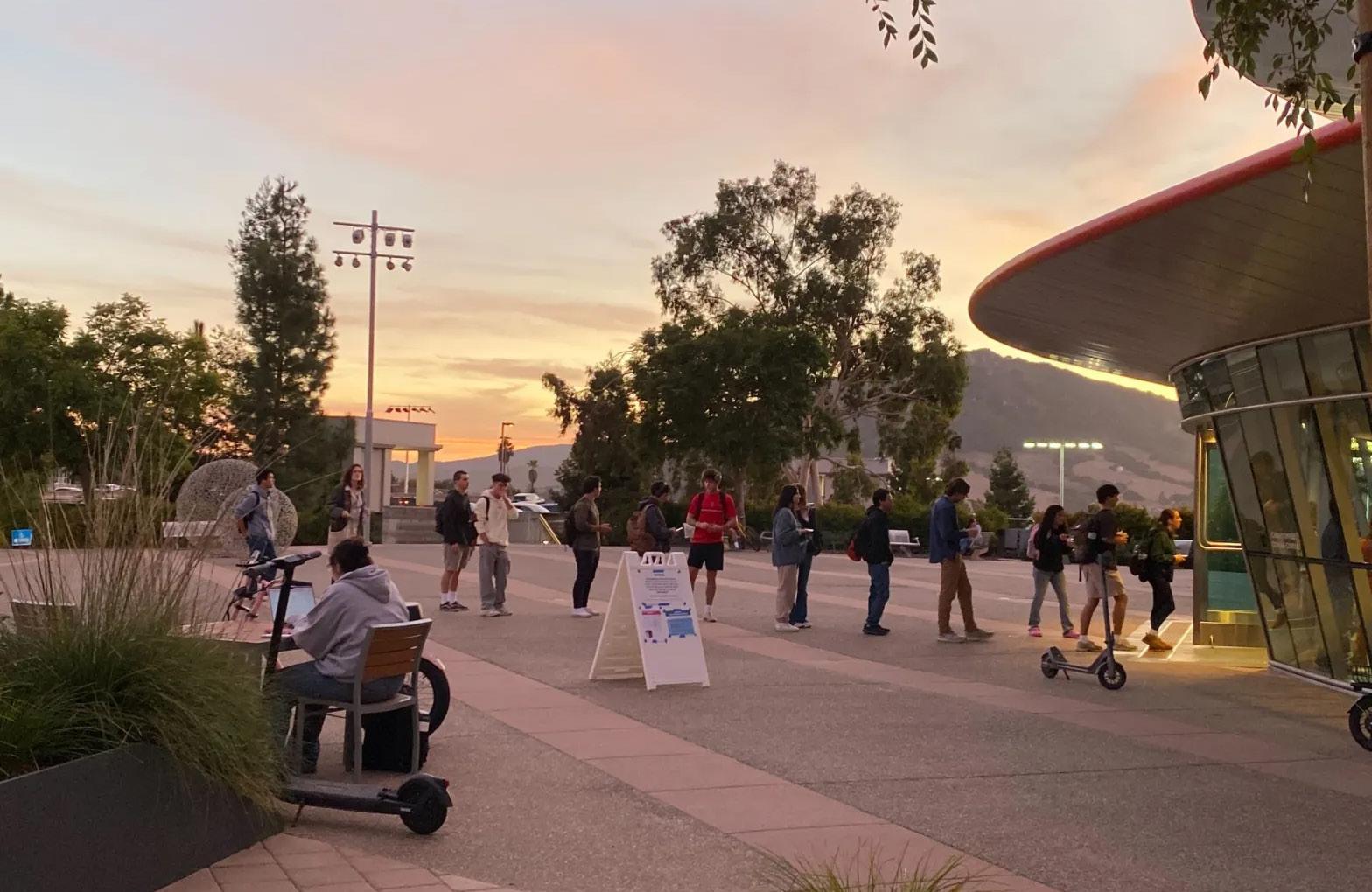
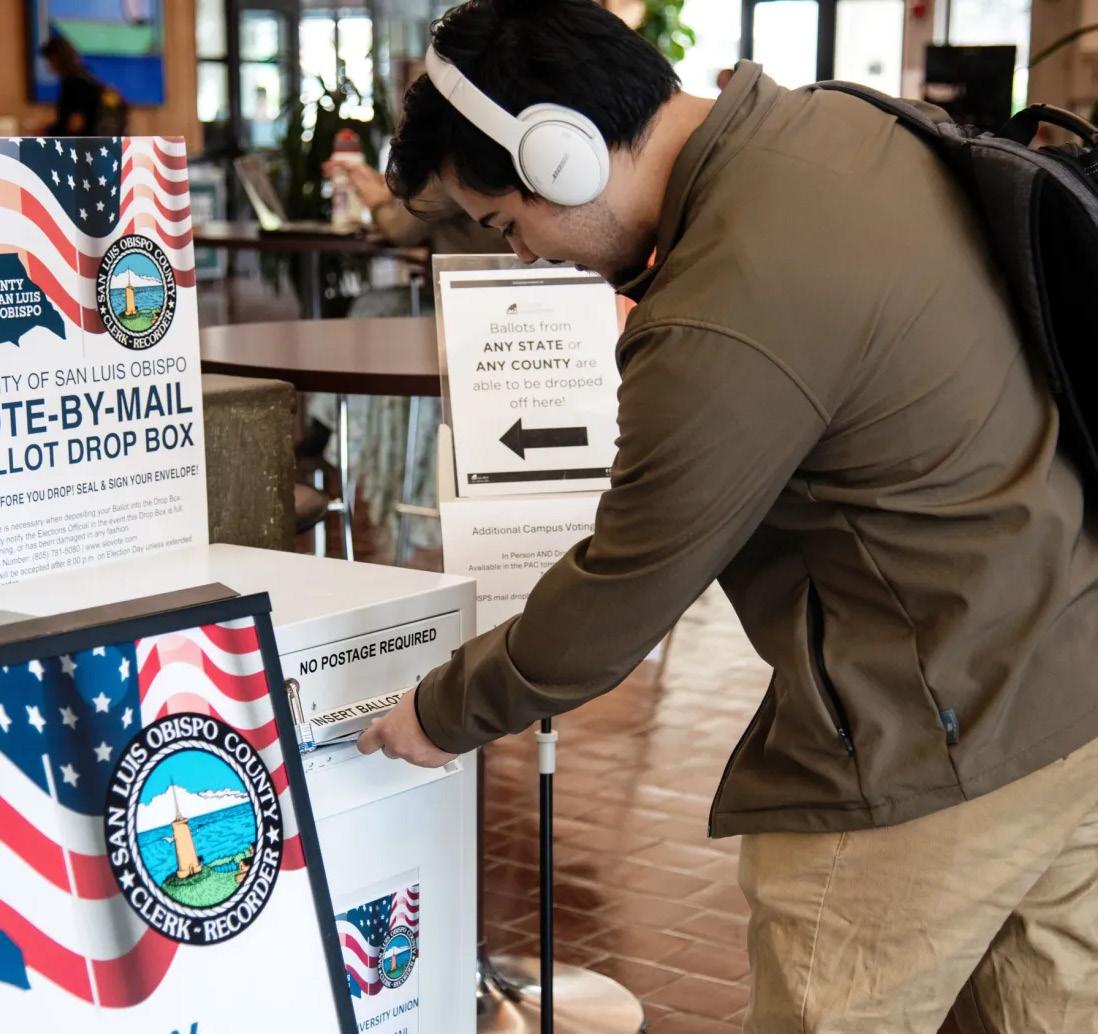
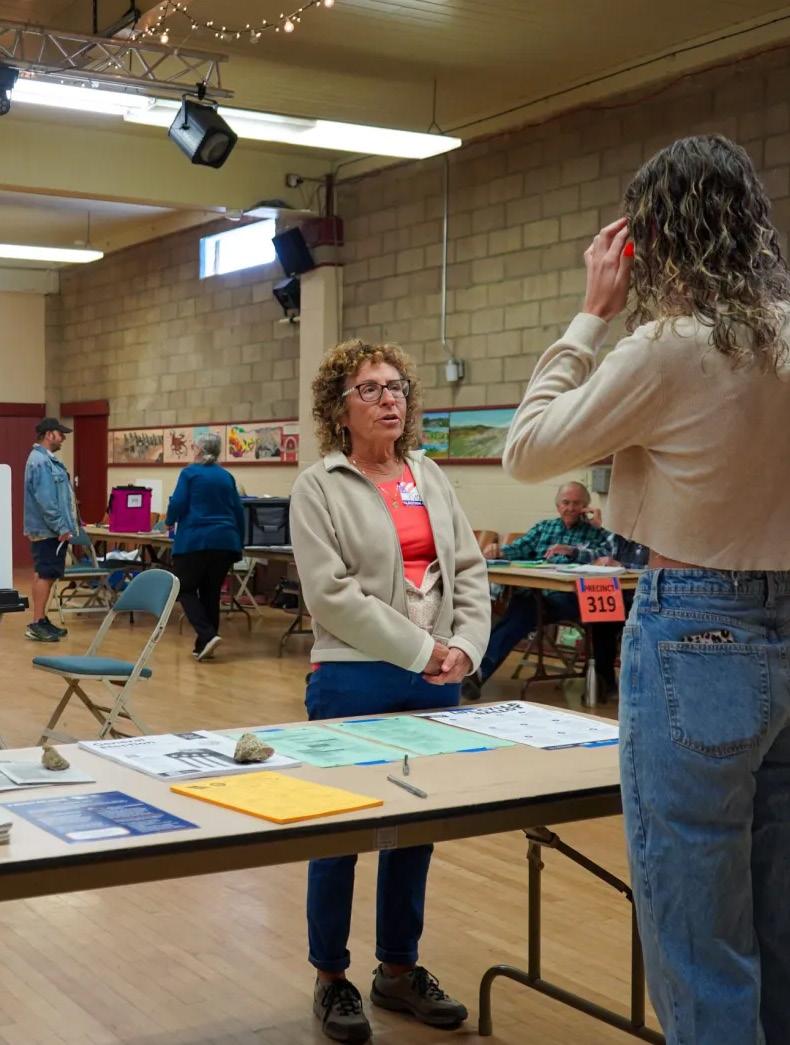

BY TY SORIA
Three words, “Live Like Keith,” have been on the back of the Cal Poly football team players’ minds this football season.
Former Cal Poly offensive lineman Keith Marco passed away in June due to a pulmonary embolism at 21 years old. After a summer of reflection, the team began wearing stickers on their helmets in his honor throughout the season.
The stickers showcase Marco’s jersey number, 55, and the words “Live Like Keith.” Keith’s friends and family used this mantra during his memorials and celebrations of life.
“We truly appreciate this incredible tribute to his legacy,” said Audrey Marco, Keith’s mother.
Head coach Paul Wulff said the stickers represent Keith’s unwavering positive attitude on the field, in the locker room, and in life.
“Every day I saw him, he was in a good mood and brought in positive vibes to the team,” Wulff said. “You’d just smile when you think of him, and
that’s how I view ‘Live like Keith.’”
Wulff was the offensive line coordinator when Marco entered the program. He said the best part of Marco was loving his teammates like brothers who loved him back.
Marco hardly played due to a mountain of injuries throughout his career. He took a redshirt year to recover from a torn ACL and meniscus tear he suffered in his senior year of high school.
He tore his shoulder in the spring of his freshman year, causing him to miss the following season. He also broke his foot in the spring of his sophomore year. Marco played in one game last season, starting against San José State University.
“He was extremely talented as a football player, and as soon as he started getting going, he had a bad break go against him,” Wulff said.
The stickers help Marco’s offensive line teammate, Tyler Charbonneau, appreciate life when things get tough.
“We’re still walking around
breathing, and I’m playing football through him, for him,” Charbonneau said.
Charbonneau and Marco entered the program in 2021, spending the majority of their time together.
Marco never failed to impress Charbonneau and the linemen with his playful antics. One year, on the first day of fall camp, the team refrigerator was fully stocked with TruMoo chocolate milk bottles, so Marco decided to take advantage.
“This kid put down eight of them in one day on his first day back,” Charbonneau said. “I’ll never forget that for the rest of my life. It was just that’s just who Keith was, and he’s just smiling, sitting there pounding his eighth chocolate milk of the day.”
In Charbonneau’s final conversation with Marco, they shared an emotional moment. During Marco’s freshman year, he lost his father due to cancer. Last spring, Charbonneau confided in Keith about his own father having cancer.
Keith told him, “It’s hard, but it’s life.” Charbonneau took this to heart, knowing that Keith lived with that mentality because he “knew how to take any situation and make it positive.”
Charbonneau said he did not know that would be his last conversation with Keith.
“It’s one of things that makes you think that everything happens for a reason,” Charbonneau said. “That conversation I had with him some random night is what I needed to hear at the time.”
As Marco was recovering from injury his freshman year, he spent a lot of time with Garrett Weichman, a redshirt senior at the time. The former offensive lineman was also recovering from a torn ACL. They often traded tips on dealing with their recovering knees. Marco also went to Weichman for football and life advice.
“He helped me a lot because he had been through an ACL injury
before,” Weichman said. “I would know my rehab process was going well because he would tell me, and we learned how to deal with the pain together.”
Weichman said Marco’s incredibly social personality is why he flourished in a fraternity and became close with all his teammates. With over 100 players on the football team, Weichman said many players would stay around the same group of people day-to-day, but not Marco.
“People just give a head nod to other people passing by, but he made an effort to say, ‘What’s up? How are you doing?’ with everyone,” Weichman said.
For more information about Keith Marco’s memory, his family set up a memorial website where people can share their stories and moments with Keith.



his ‘why’ – and the Big West title
BY ANDREW AGUINIGA
Before stepping onto the pitch during the final regular season match against Cal State Bakersfield, Quinn Mahoney wrote seven letters “M, D, M, M, G, S, I, B,” around his wrist on a tightly wound wrap.
The letters represent those closest to the redshirt freshman midfielder: his mom and dad, his sisters Meghan and Molly, his grandparents, his supporters, his injured teammates and his best friends back home.
Mahoney dedicates each game to the people who supported and uplifted him during one of the most difficult periods of his life—a time when his entire soccer career was in jeopardy.
Just before entering his first summer practice with the Cal Poly Men’s Soccer team, Mahoney played in the Elite Clubs National League.
After helping lead his team into the playoffs, he suffered two grave injuries during a playoff match that would keep the incoming freshman sidelined for months.
Medical professionals diagnosed Mahoney with chronic whiplash and a concussion, injuries that could possibly permanently damage the neck and brain, respectively.
The idea of Mahoney having to medically retire had begun to take shape, and the likelihood of it happening appeared to be growing by the minute.
It was ultimately determined that Mahoney would not be forced to retire. However, due to the injuries, he would have to undergo an extended period of rehabilitation that would keep him out for the 2023 season.
Mahoney chose to redshirt his freshman year and forgo any potential chance of playing time that
QUINN MAHONEY | MUSTANG NEWS
Quinn Mahoney has a tradition of writing the first letters of the names of people close to him before every game on his wrist.


season.
After sitting out the season, Mahoney made his collegiate debut at the beginning of the 2024 regular season.
He would experience a breakthrough in a match against Gonzaga, scoring his first Cal Poly goal, recording his first assist and six shots.
JUMP-STARTING THE OFFENSE
He started to find his stride and scored in the next two games. Mahoney instantly became the team’s leading scorer.
The Mustangs would go on to record their best season in nearly ten years. In the 2024 regular season, they earned the regular-season crown and the No. 1 seed in the Big West Men’s Soccer Championship— the first time in program history for both.
In addition, the Mustangs notched a nine-game unbeaten record during the regular season, including an unbeaten record at Mustang Memorial Field, the program’s lengthiest unbeaten run since 2007. As the season drew to a close, Mahoney collected his first Big West Men’s Soccer Freshman of the Week accolade after bolstering the Mustangs to an unbeaten week of
helping bolster a Cal Poly offense that, alongside stellar defense, appeared to will the Mustangs to the top spot in the Big West.
“Coming into college, I had my eye on it but unfortunately my freshman season took a turn,” Mahoney said. “I owe it all to the people around me that have supported me through my journey.”
Mahoney was introduced to soccer as a child by his immediate family. At just three years old, his family would usher the toddler outside into the backyard to shoot on a goal.
Mahoney and his two sisters would continuously set out to rocket the ball past their parents to score a goal.
The young midfielder continued
to play the sport past his formative years and into his childhood in extracurricular clubs. As Mahoney grew, so did his love for the sport, but it came to a screeching halt once the injuries came into play.
Mahoney’s passion for the game he loved was tested. The weight of a possible medical retirement and watching his team play without his help affected his mindset.
“It was one of the hardest times in my life,” Mahoney said. “Not knowing if I was able to play soccer again brought me to tears many times.”
The men’s soccer team played a focal role in helping the Sacramento native return to form.
Despite being unproven at the collegiate level, the Mustangs were quick to accept Mahoney as one of their own, which bolstered his
CHLOE BRIOTE-JOHNSON | MUSTANG NEWS
Quinn Mahoney has been a crucial piece to the Cal Poly offense in 2024.
confidence as he recovered from injury.
“My team had no idea if I was going to be good or not but every player showed me respect,” Mahoney said. “They all checked up on me and that made me feel connected to the team. I felt like I found another family away from home.”
Through reflection, the redshirt freshman found the motivation to persevere and play with the support of those around him and those closest to him.
“I was able to connect with the people I love the most and find my ‘why,’” Mahoney said. “I can work so hard because of the people that helped me overcome the toughest part of my life. I wouldn’t be anywhere without the love and support from those from my hometown and the
BRIOTE-JOHNSON | MUSTANG NEWS
games in October.
Mahoney finished the season as the team leader in both goals (four)
It was one of the hardest times in my life...Not knowing if I was able to play soccer again brought me to tears many times.
QUINN MAHONEY
Cal Poly Men’s Soccer Midfielder
and assists (five).
“I think he’s kind of a hybrid of being able to drop in and help us get the ball in the pocket,” Kennedy said.
“But he’s also able to score goals and is dangerous on the attacking piece, and I think he’s a great connector for us.”
Mahoney was named the 2024 Big West Freshman of the Year — after

The culture around dining dollars needs to change: “We never know the details of somebody else’s financial capabilities
BY ASH PICKETT
Ash Pickett is a business administration junior and opinion columnist for Mustang News. The opinions expressed in this article do not necessarily reflect those of Mustang Media Group.
I picked up the phone one day early winter quarter of my freshman year. On the other side of the line was an upperclassman who asked if I was busy. I told her I was between classes, so she asked if I had any extra dining dollars and would be down to do a quick Shake Smart run with her. With a freshly re-loaded allocation of dining dollars in my Grubhub account for the new quarter (and a newfound açai bowl obsession), I gladly agreed and there went an extra $24 down the drain. As we ate our bowls in the University Union, she talked about how when she was a freshman, she paid for upperclassmen’s food on campus all the time. I
was just giving back to the cycle by spotting her. Little did I know, this was the first of many times I’d be paying for upperclassmen, and it’d end up wiping me clean of dining dollars before the school year was over.
Besides, dining dollars are fake money! Students are reminded about this daily living in the dorms–it’s a big inside joke that dining dollars don’t feel real since they’ve already been paid for at the beginning of the school year. They’re a deep endless well in the form of a digital Grubhub account, from which you can buy unlimited Scout Coffee lattes and Campus Market breakfast burritos.
But that’s just the thing–dining dollars aren’t unlimited. I, like many others, had to find that out the hard way.
The purpose of dining dollars is to make food more accessible to students who are new to college and adjusting to new environments,
friends and homesickness. The culture surrounding them undermines that though, and the perspective that dining dollars are “fake money” forces students to make the decision between being financially responsible and pleasing upperclassmen. It can be emotionally and mentally straining, and it definitely became that for me.
“It tricks you into spending more, so I was more prone to spend more on Shake Smart and other places where the prices were really high. The one-step disconnect between money and dining dollars was tough,” said business administration senior Jaden Lipson, who also ran out of dining dollars multiple times his freshman year.
Early on in my second year at Cal Poly, I found myself calling up a first year and asking him if he’d grab a bowl with me from the newly-built 1901 Marketplace, remembering
his generous offer the week earlier to pay for my lunch with his dining dollars. While we sat and talked, I couldn’t help but feel a sense of guilt.
Who was I to take advantage of someone else’s dining dollars, even if they offered first, or claimed to have “extra?” Asking a freshman to pay only encourages them to engage in frivolous spending before they understand the pace they’re spending at, which can lead to a deficit in money for food later on.
Plus, those dining dollars were funded by either themselves or their supporters–it was still their hard-earned money, not mine. Upperclassmen should ask themselves that same question before asking their younger friends to spot them.
We need to take the term “fake money” out of our collective Cal Poly vocabulary and be more mindful about respecting other students.
We never know the details of somebody else’s financial capabilities, and asking freshmen–who are knee-deep in a period of major adjustment, vulnerability and malleability–to pay for food can be insensitive at times. This isn’t to say that buying lunch for friends every once in a while is a bad thing. Nor does it mean students spending their extra money on friends near the end of the year are being taken advantage of. It’s generous and kind to treat friends every once in a while.
We simply need to be mindful of the language we use surrounding dining dollars and the culture we create in asking for favors from others. It is a privilege to fall into the “fake money” sentiment, but it happens to many students all the same. As a collective, we need to protect our freshmen from financial burdens in their first year on campus, and dining dollars are a crucial expense to consider.
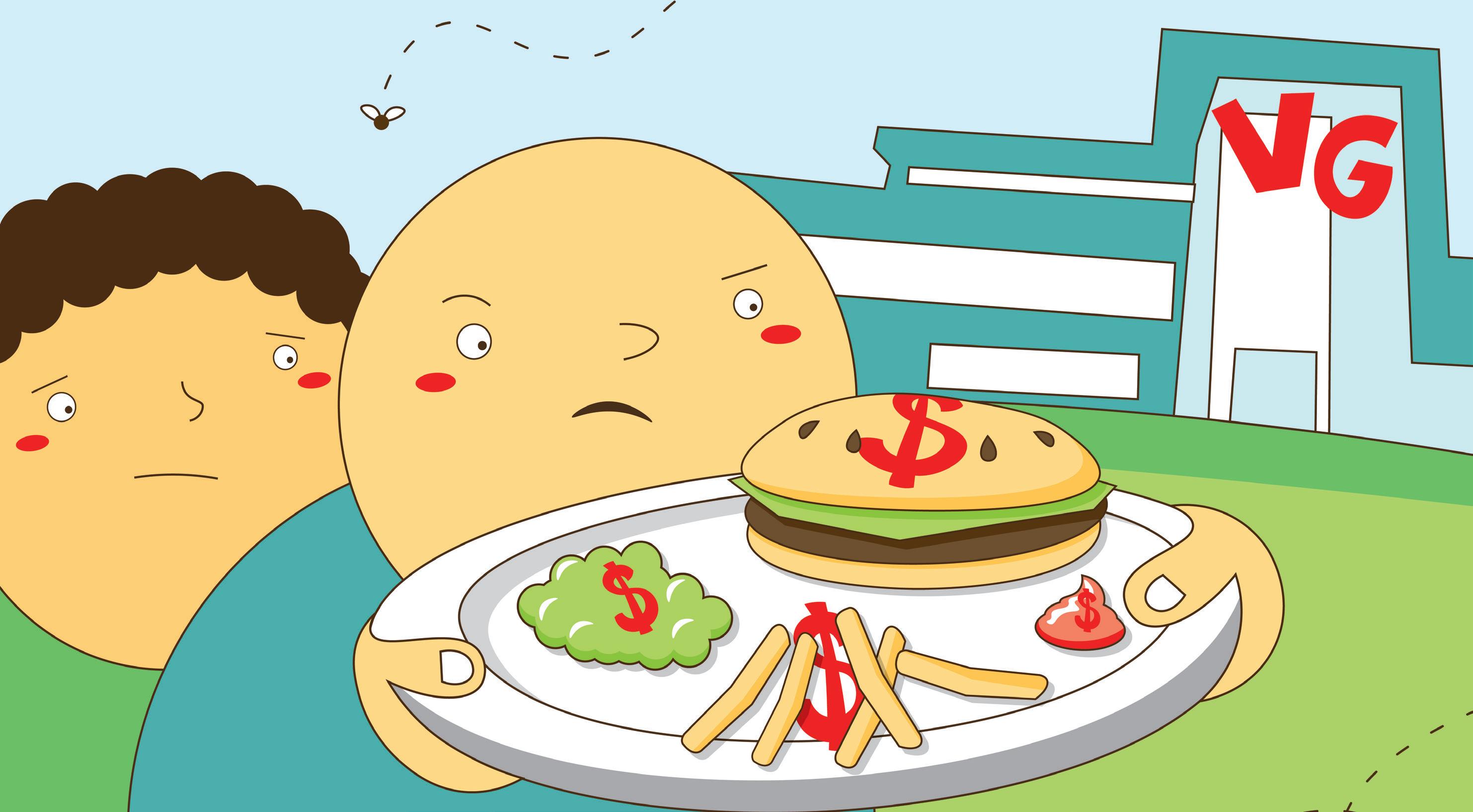
BY JESSICA CARP
Pickle enthusiasts gathered for the first-ever San Luis Obispo Pickle Festival in earlier this month at Laguna Lake Park. The event featured local vendors and live music. An assortment of pickle-infused food and drinks were also available for festival-goers, like Ethan Siapush, to try.

“I’ve had a pickle-flavored cupcake and pickled shrimp,” Siapush said. “The cupcake’s winning so far.”
This festival featured vendors and live music such as live pickling demonstrations and a pickle-eating contest. Some attendees competed to see who could finish a bowl of pickles the fastest. Mori Scheer won first place.
Scheer attended Pickle Fest with two of her pickle-loving friends.
“My girls are just like me, they love dill pickles,” Scheer said.
For Scheer, pickles are more than just a condiment.

“Childhood memories, I would save my money and I would go to the Esplanade and I would buy the big pickles at Hickory Farms,” Scheer said. “It was like my treat, and so, I’ve loved them ever since.”
The festival was a fundraiser hosted by Meals That Connect, a local non-profit senior nutrition program.

The program provides over 1,000 free meals to seniors in San Luis Obispo every day, according to event organizer Elizabeth Denny.


This story earned second place in the Broadcast Feature Story, Best of Show category at the 2024 Associated Collegiate Press award show. To watch the full video, visit the QR link below.



“We had a great turnout. We had a sold out event, especially for our first year, it was incredible,” said Denny.
“It’ll provide many, many meals for our seniors in need. We’re so thankful for everybody that came out and was able to support this event in one way or another.”

Denny says that they are already planning next year’s pickle festival.


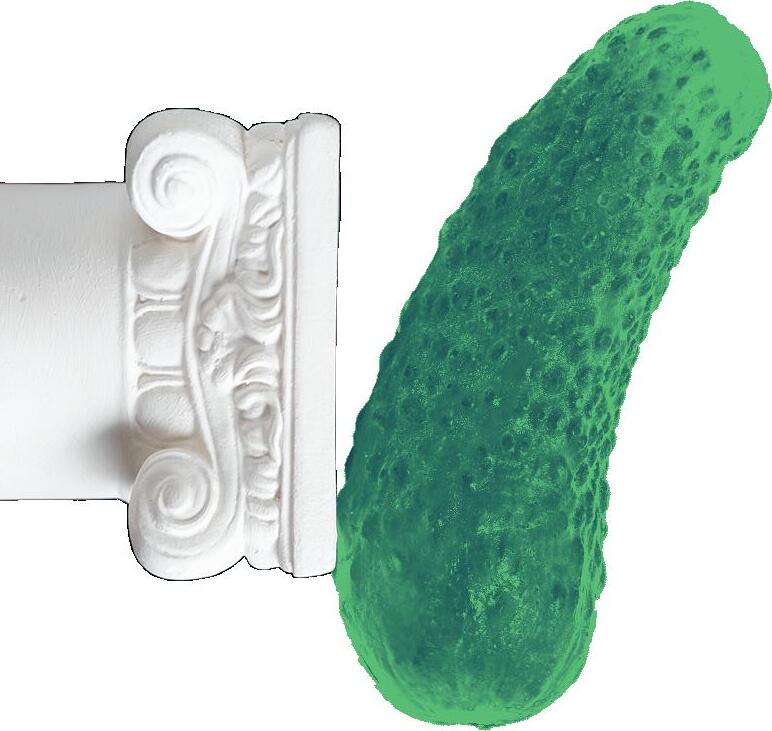

SCAN TO LISTEN ON SPOTIFY
this mean for the future
BY JEREMY GARZA
Cal Poly Hispanic/Latino enrollment reached 25% for the first time, a major requirement to become a Hispanic Serving Institution (HSI), according to a university press release and the HSI symposium on Oct. 30.
To officially apply to be an HSI, the university has to maintain 25% Hispanic/Latino enrollment for two years. HSIs are eligible to receive specific grants from the federal government. There are no requirements that universities spend funding directly on Hispanic/Latino students.
“We’re so excited for this, but this is not a stop gap,” said Beya Makekau, the associate vice president for diversity, equity and inclusion strategic planning and networks. “We are going to remain committed. We are going to remain vigilant in serving and enrolling this population and cultivating a campus community that represents them.”
To become an HSI, Cal Poly must also demonstrate a high concentration of students who are eligible for federal Pell Grants. Pell grant-eligible students make up 23% of total enrollment, up from 19% in 2023.
The school will file for an exception to the Pell Grant requirement, according to Denise Isom, vice president for diversity and inclusion and chief diversity officer.
“We actually hold AANAPISI status, Asian American and Native American Pacific Islander-Serving Institution, and Minority Serving Institution status, both of which we have applied for with that exception,” Isom said of the Pell Grant exception at the symposium.
Latinx/e students comprise approximately 29% of the incoming class, or 1,802 students this year.
Incoming Latinx/e student enrollment has grown steadily since 2018. Around 40% of Californians identify as Hispanic/Latino, according to US Census data. Cal Poly President Jeffrey Armstrong said there is more work to do as Cal Poly moves towards matching California’s demographics.
We have more qualified Hispanic identifying students that we could not admit than we had total qualified applicants five years ago
JEFFERY ARMSTRONG
President of Cal Poly at the HSI Symposium on Oct. 30
“We are here to serve high-achieving high school graduates of California,” Armstrong said. “We are going to work tirelessly [until] we better match California.”
Cal Poly is no longer a predominantly white institution, as white students now make up less than 50% of the enrollment. However, Cal Poly is still a historically white institution.
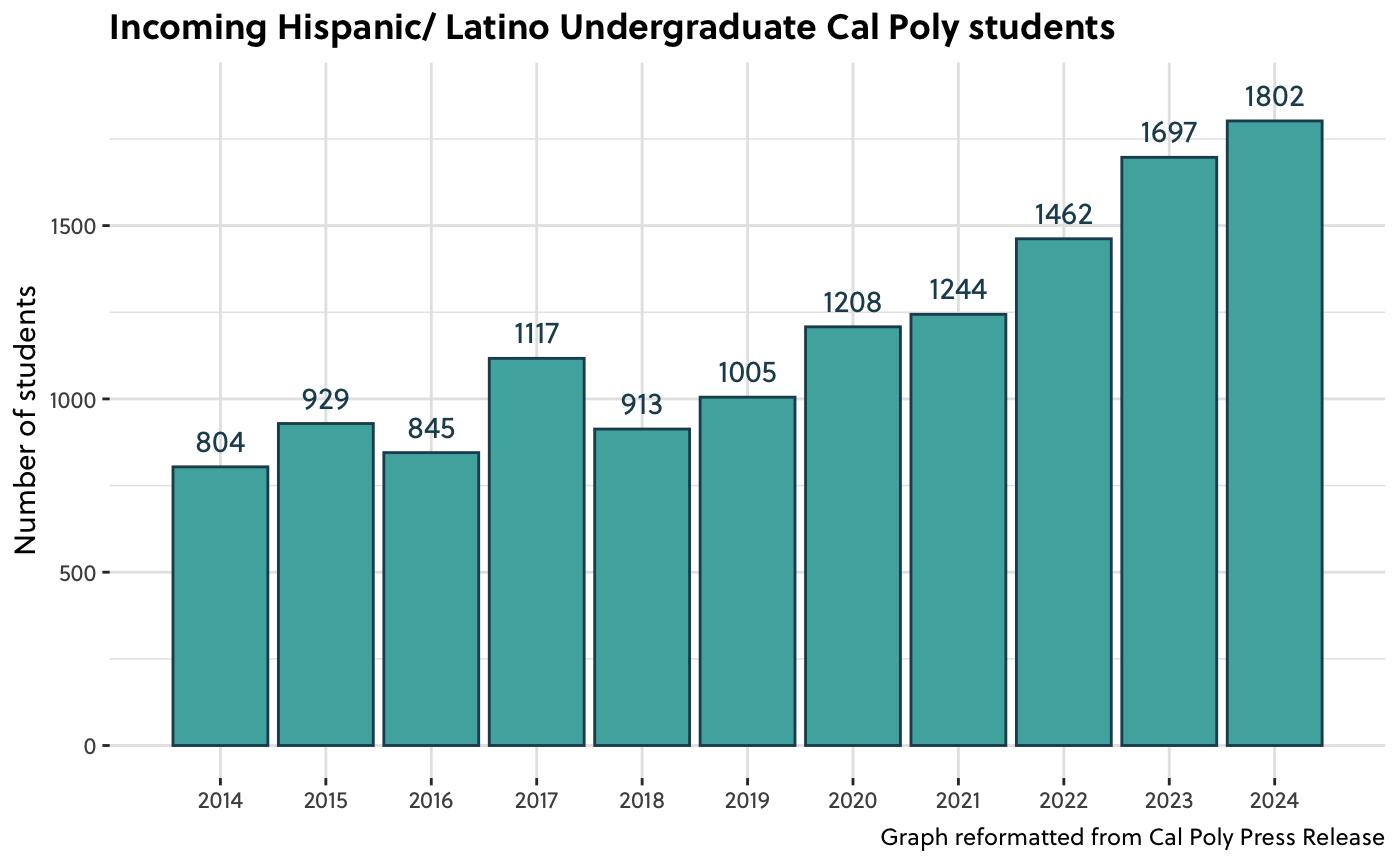
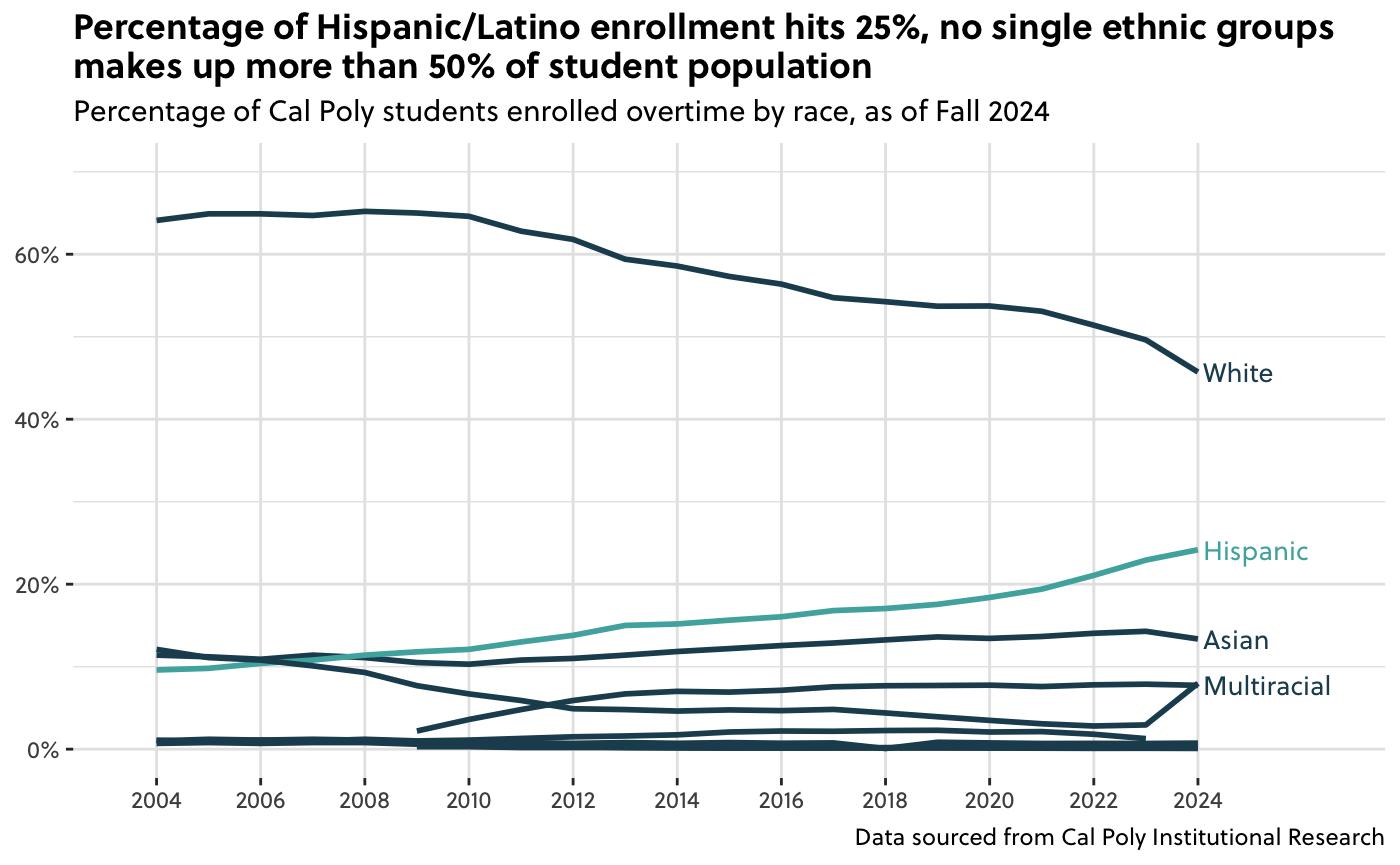

“We have the potential of remaining a culturally white institution, an institutionally white institution, a systematic and structurally white institution, if we do not continue
centering the pieces of the work that are at the heart of our effort in becoming HSI,” Isom said.
Cristian Ulisses Reyes, a higher education counseling/student affairs

master’s student, was one of the student panelists at the symposium.
“Although Cal Poly is a dominantly white institution, it’s about the efforts that are being made at
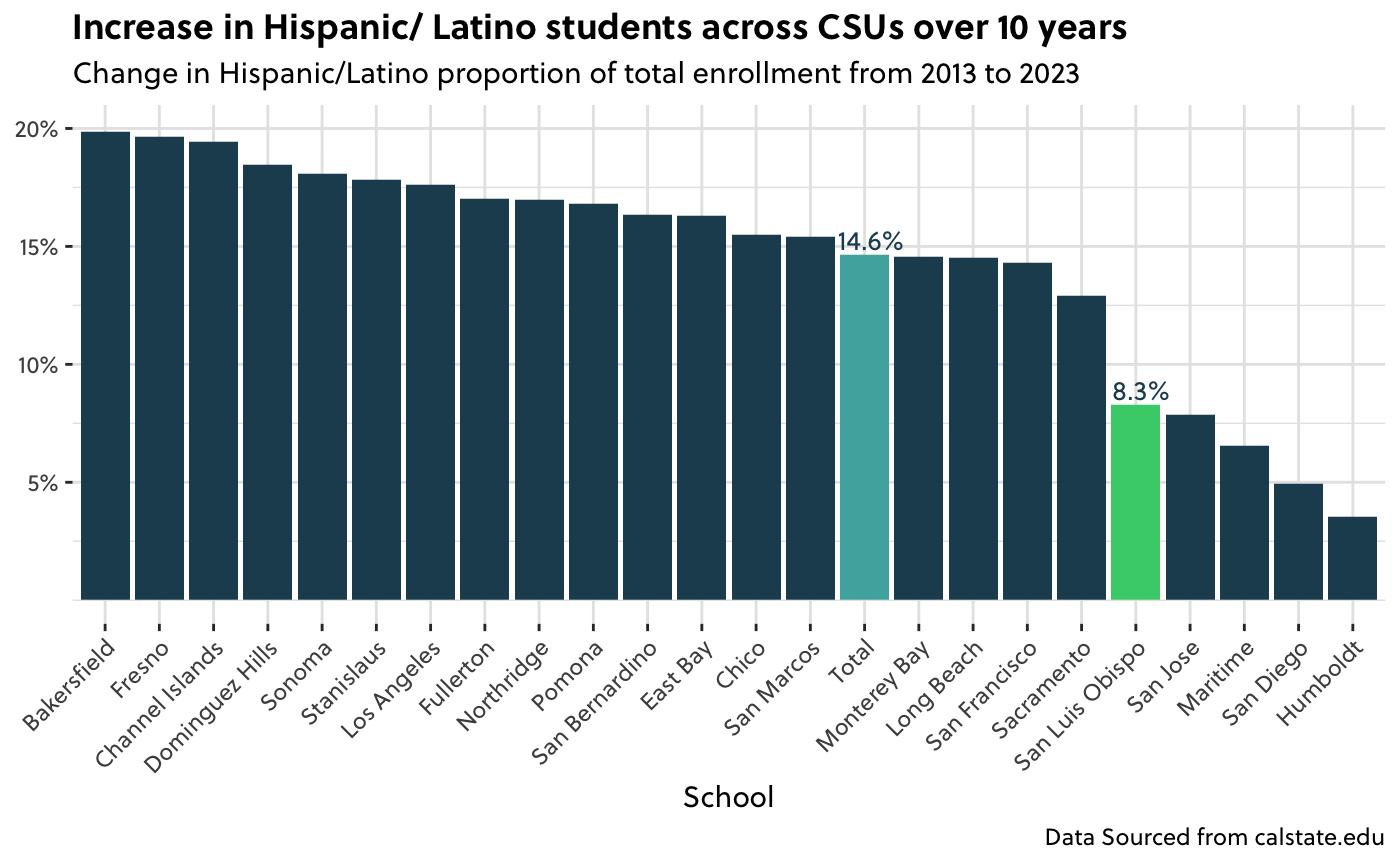
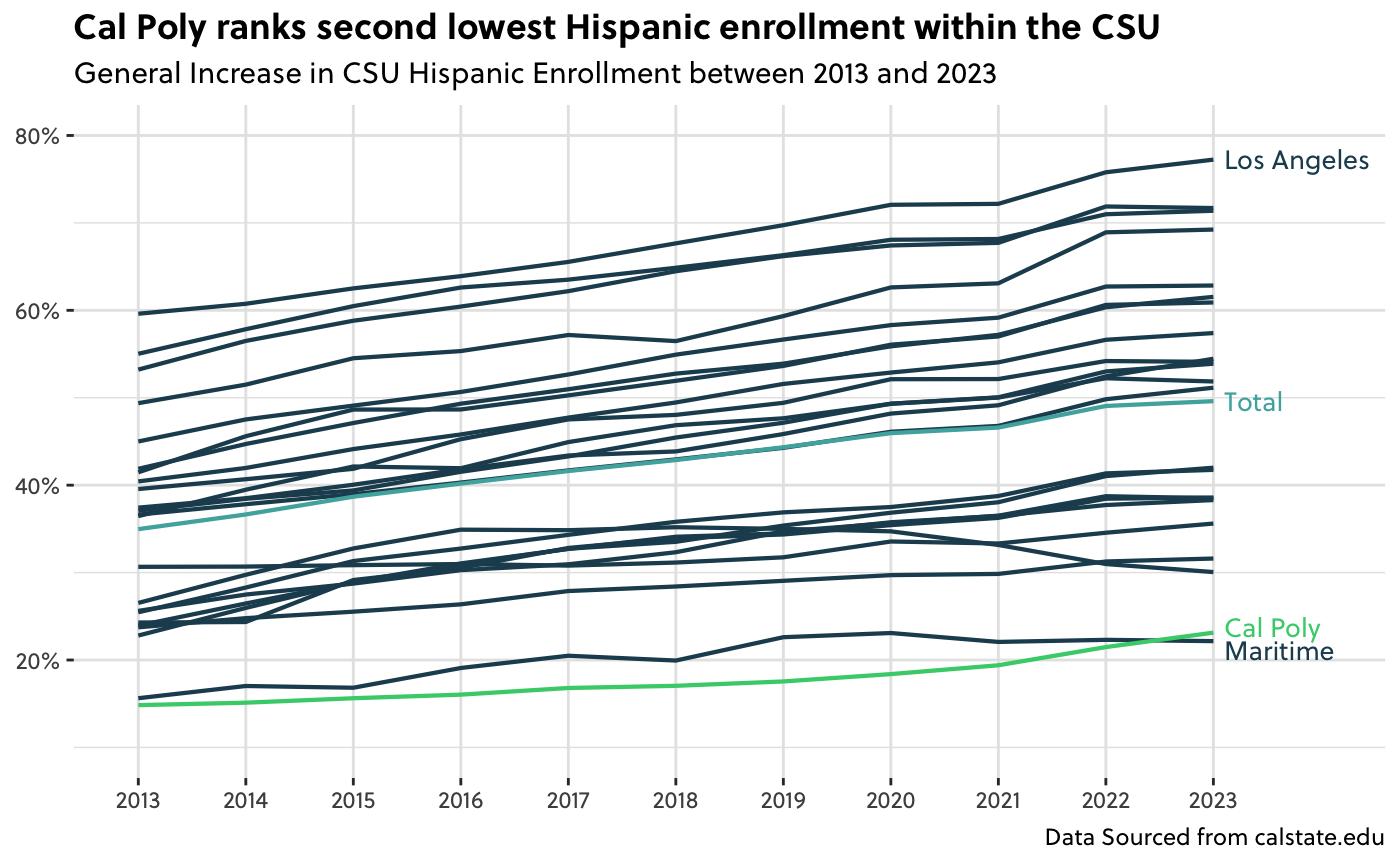
an institutional level,” Ulisses Reyes said. “It’s about the faculty that are working at the institution making those classes for students. As long as that intention remains there and student voices are on the forefront, we’ll be just fine.”
Only 44 tenure-track faculty identify as Hispanic/Latino, approximately 7% of all Cal Poly faculty. People who identify as Hispanic/ Latino hold 12% of Cal Poly management positions as of 2023.
According to Isom, the College of Liberal Arts hired twenty new faculty members through DEI cluster hiring, sixteen of whom are people of color. They also ran an HSI-specific cluster hire, which led to the six new faculty members who are focused on expertise in Latinx/e studies.
The DEI cluster hiring process is expanding to be a university-wide program this year, with a focus on HSI and Black student success, according to Makekau.
“We had the registrar explore how many courses in our campus catalog included a title that had the word ‘Hispanic,’ ‘Latinx,’ ‘Latine’ or ‘Mexican’ in it. It was less than seven,” Isom said. “The clusters mean curriculum changes. It means what students are exposed to changes. It means the foundational knowledge of our majors change.”
Students, like Industrial Technology and Packaging (ITP) junior Alexis Espinoza, want to see themselves represented in the classroom.
“There’s finally an ITP professor who’s a Latino and I am very close to him,” Espinoza said at the student panel at the symposium. “We speak Spanish to each other in the classroom, and that’s something that I look forward to. Every time I see him hosting a class that I need, I always make sure to sign up.”
Cal Poly has seen a 12.5% growth in incoming transfer students since last year? Or when. More than 800 students from the incoming class come from the local area, 25% higher than last year’s incoming class. More than half of incoming students from the local area are Hispanic/Latino.
“We’ve seen programs like ignited by excellence, where high school students from our partner schools spend a day on this campus,” Isom said. “We’ve done a couple around Latin students and African American students each year. The number is growing every time, the relationships deepening every time, as they have with our community colleges as well.”
Cal Poly and the California State University system are planning a merge with Cal Maritime. The two universities have the lowest Hispanic/Latino enrollment rates in the CSU system.
“[HSI] is a status, but at the same time is a new baseline,” Armstrong said. “If the [CSU] board approves the integration of [Cal]-Maritime with Cal Poly, CSU universities will all be Hispanic serving for the first time.”
Cal Poly’s Hispanic/Latino proportion of total enrollment has grown by approximately 8%. This is lower than the 14% average growth system wide, according to CSU data.
Editor’s Note: This story uses Hispanic, Latino and Latinx, according to individuals preferences. Cal Poly’s enrollment data uses Hispanic/Latino, while the university’s diversity office prefers Latinx/Latine. Mustang News follows a style preference for Latinx.
BY ALIE HALL & ALEX TRAN
When Ethan Thai was 17, he left Vietnam and immigrated to the United States with the help of family members who sponsored his move. Ethan, whose Vietnamese name was Gia Hung Thai, looked to find an American name for himself. He decided to base his name on Tom Cruise’s character, Ethan Hunt, the main character in “Mission: Impossible.”
Fast forward, and he’s a junior in business administration at Cal Poly. The university was his top choice, partly because of its ideal location— not too close but not too far from home.
I’ve seen one other Ryan on campus. I don’t know, it’s just a name.
RYAN LE
Construction Management Freshman
It just so happened that Ethan also picked one of the most common names at Cal Poly.
“I am surprised,” Thai said. “I didn’t know that it was the third [most] popular name.”
From the 23,400 students, the most popular names in order are Ryan, Jack and Ethan, according to data gathered by Mustang News using the 2024 Cal Poly student directory. The fourth and fifth ranks are traditional feminine names, Emma and Sophia.
“I kind of knew that my name was one of the most popular names in the world,” theater arts sophomore Emma Frank said. “I think I’ve looked it up before. It doesn’t surprise me that much.”
The most popular name at Cal Poly is Ryan, with 206 people sharing the first name. With 23,400 students on
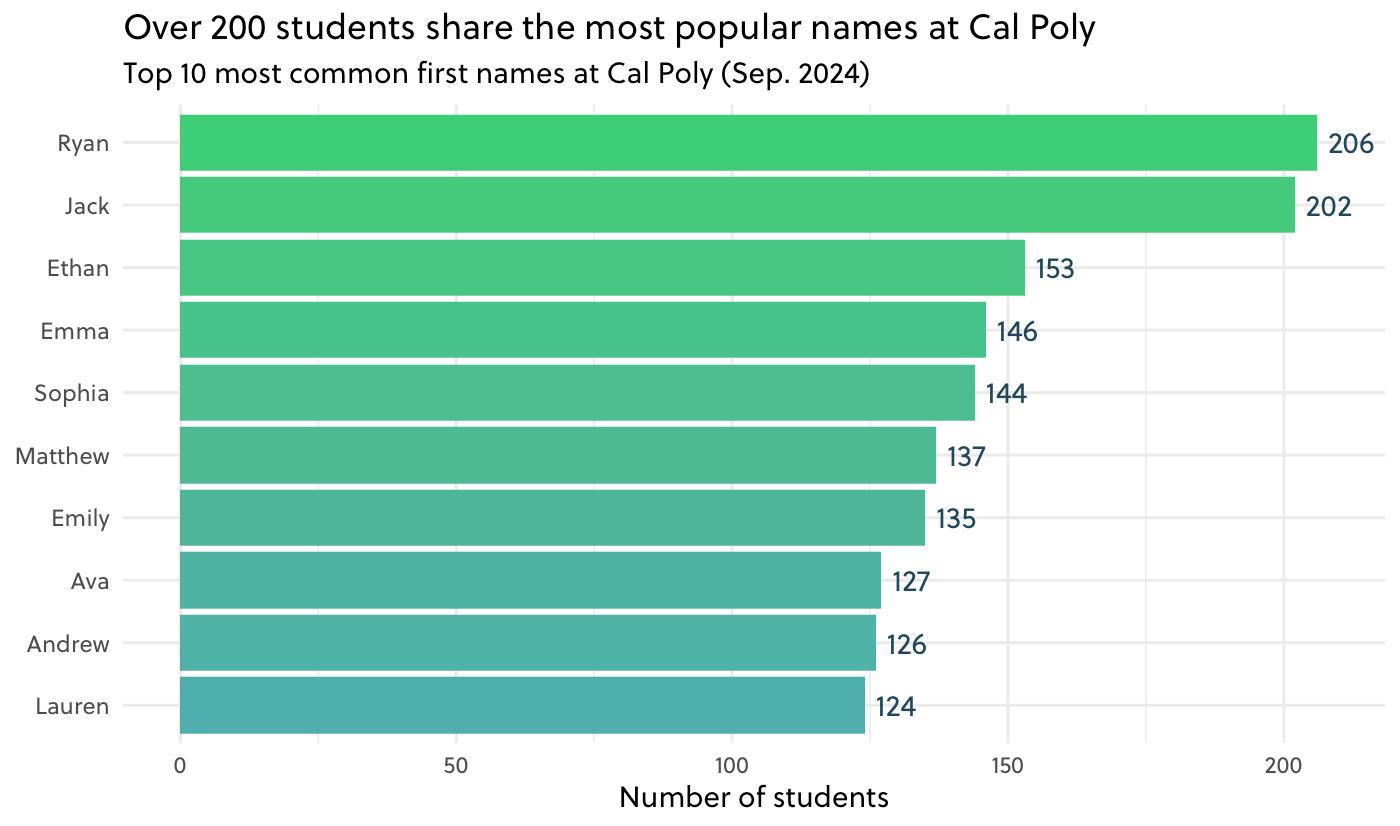
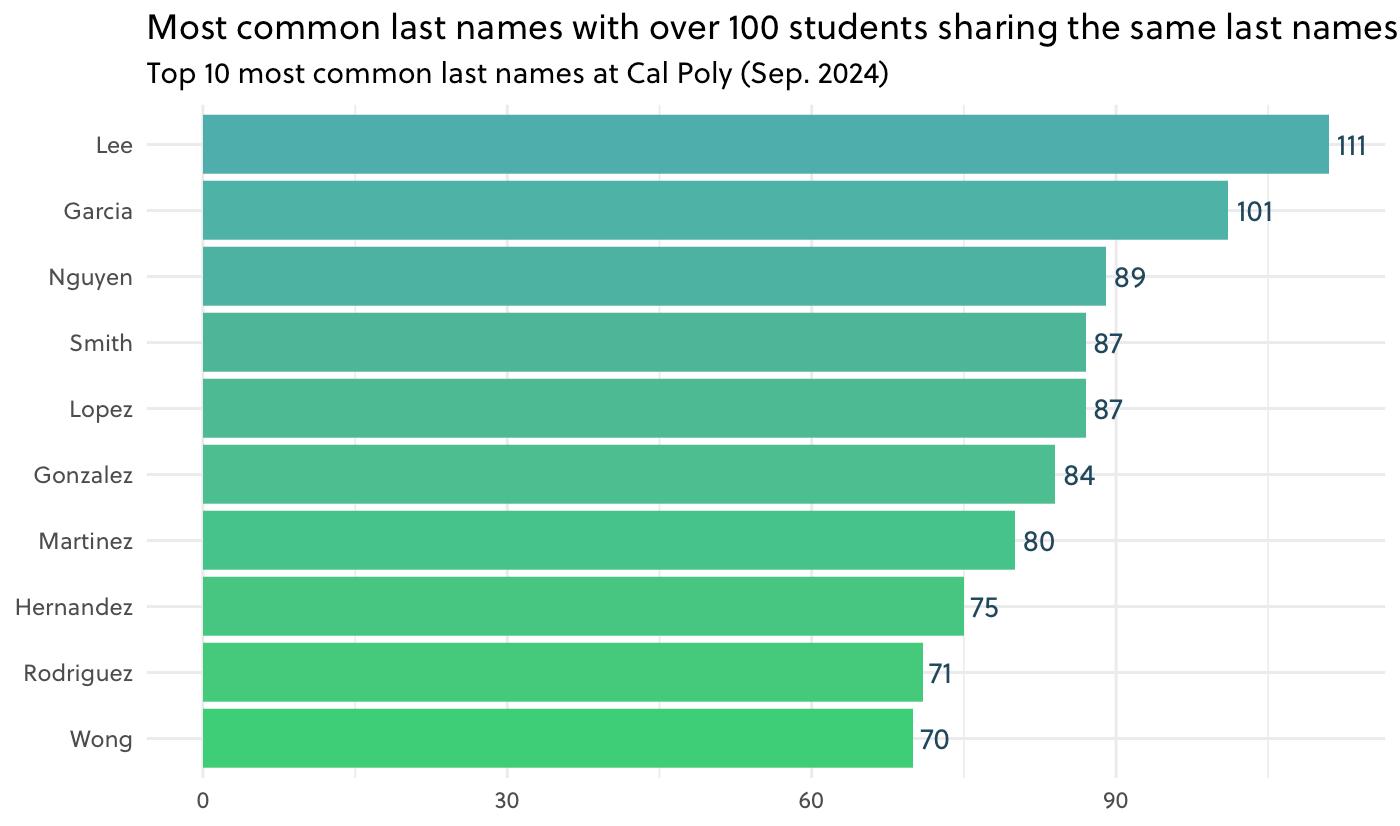
campus, that is approximately one in 125.
Although one in 125 is common, there is no guarantee that people will run into name twins.
“I’ve seen one other Ryan on campus,” construction management freshman Ryan Le said. “I don’t know, it’s just a name.”
Although Ryan is the most popular name on campus, Jack isn’t far behind.
“Through high school I knew a lot of Jacks, and again at Cal Poly I met a bunch of people named Jack or an offshoot of Jack like Jackson or Jacks,” art and design freshman Jack Meyer said.
Cal Poly’s overall top names are reflected in the most popular names through the different academic colleges. However, more apparent is how the different academic colleges have vastly different proportions of female and male students.
For example, the College of Engineering’s most popular names are all masculine, while the College of Liberal Arts top names are feminine. This reflects the gender divide between colleges, as seen below.
According to 2023 data from Cal Poly Institutional Research, 53% of Cal Poly’s student population identify as women, 46% as men, and 0.23% as non-binary. Each college has different female-to-male ratios.
The College of Liberal Arts has the largest gender gap, followed by the College of Engineering.
When looking at Cal Poly’s student population as a whole, the drastic gender disparity present in some of the academic colleges can be easily overlooked.
Jack and Ryan hold a continued popularity. Notably, Olivia is the most popular name for juniors, while not present in the overall top 10.
Please note the data does not encompass alternate spellings of the same name–for example, Sophia and Sofia are counted differently. In addition, the Cal Poly directory determines grade level by the number of units a student has completed, rather than the number of years at Cal Poly or degree completion.
Full story found on mustangnews.net
The College of Liberal Arts has the largest gender gap with 72.2% women and 27.3% men, followed by the College of Engineering with 69.4% men and 30.6% women.

